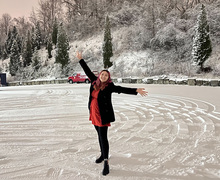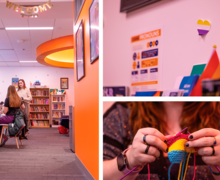SU recalls engineering professor for dedication, cheerful attitude
Hiroshi Higuchi approached Achille Messac one Thursday afternoon earlier this fall to tell him Higuchi’s doctor ordered Higuchi to begin his stay in the hospital by the next day.
But Higuchi assured Messac that he told his doctor he would have to wait until Monday. Higuchi had to attend the faculty’s first Friday lunch with Messac, the new chair of the mechanical and aerospace engineering department at the L.C. Smith School of Engineering and Computer Science.
‘He was so devoted,’ Messac said. ‘I would visit him in the hospital, and he had just finished reviewing a journal article or sent out his own article.’
Higuchi, 63, a professor of mechanical and aerospace engineering, died Nov. 22 after a long battle with leukemia. Colleagues and students said his 21 years as a professor at Syracuse University are marked by devotion to his students and a job that was helped by his wide range of interests and skills.
‘He was the kind of professor you read about and wish you know,’ Messac said.
Higuchi, a trained pilot, was responsible for acquiring L.C. Smith’s first flight simulator, dubbed Tango Foxtrot. He interacted with alumni to obtain funding, integrated it into his classroom and developed a course devoted to the flight simulator.
Messac first met Higuchi last spring when he came to interview for the department chair position. Higuchi immediately took Messac to the flight simulator. During the simulation, Messac crashed into the ocean.
‘I took a look at him, and he said, ‘Don’t worry, I’ll fix it,” Messac said. ‘Right then, I knew I was in good hands.’
Mark Glauser, associate dean of research at L.C. Smith and frequent research partner for Higuchi, said Higuchi’s knowledge of piloting made him a unique and effective professor. Glauser guessed Higuchi logged 1,500 to 2,000 hours in the air, providing him with an intuition about the physical phenomenon of flying.
‘He provided motivation to students because he showed how what they were learning connected to actual physical phenomena,’ Glauser said.
Higuchi’s focus on the physical aspects of aerospace engineering also translated to a photography hobby, Glauser said. Higuchi photographed physical phenomena, such as a vortex that formed in the clouds behind a plane. He later recreated that same photograph in a water tunnel at SU. The two photographs allowed him and others to study the vortex creation.
Higuchi was also instrumental in establishing a relationship between L.C. Smith and Tohoku University in Japan, the third highest ranked university in the country, Glauser said. Higuchi made such an impact at the Japanese university that a colleague from Japan flew over for the day to attend the calling hours Friday.
Glauser traveled to Japan with Higuchi one time, and the two visited four labs together. Glauser could see how well respected Higuchi was, he said.
‘There was just a sense that ‘Wow, professor Higuchi is here,” he said.
Morgan Nowak, a senior aerospace major who helped Higuchi on various research projects, traveled to Japan for research with Higuchi this summer as part of the partnership with Tohoku University. Nowak said Higuchi did a good job of making him feel at home by showing him around, taking him to meals and introducing him to professors.
Nowak said Higuchi stood apart from other professors in his dedication to having students succeed. For instance, Higuchi encouraged Nowak to present his own research paper at a conference, even though undergraduate students usually have a professor present research for them.
Higuchi also pushed his students to learn. Whereas some professors teach with the sole aim of having students pass the course, Higuchi taught to ensure students understood the material well, Nowak said.
‘In math and engineering, you could learn equations, but you could also learn deriving,’ Nowak said. ‘Professor Higuchi made sure we knew how to interpret what we were learning.’
But Higuchi also often lightened the mood of his class with random anecdotes, Nowak said. He once told the class about a time he flew to Martha’s Vineyard, bought a cup of coffee and then flew back home.
‘He said it was one expensive cup of coffee,’ Nowak said.
Above all, Nowak said he will remember Higuchi’s dedication to and enjoyment of his job, something that never ceased.
‘Even when he was in the hospital, he was constantly asking about our research,’ Nowak said. ‘Just two or three weeks ago, he was setting up Skype so he could participate in conferences.’
Published on November 30, 2010 at 12:00 pm





